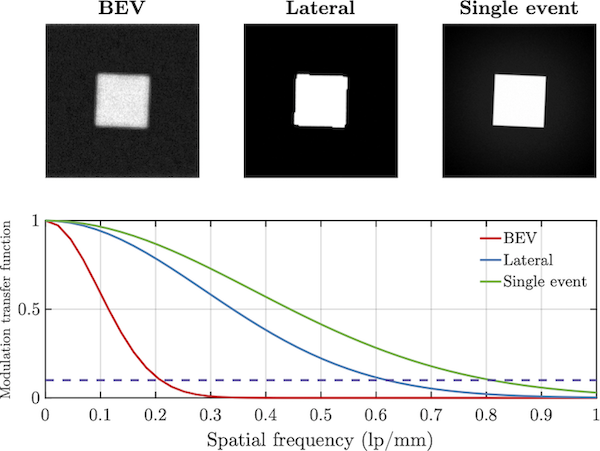Integrated-mode proton radiography using 2D lateral projections and a scintillator
Mikael Simard,
United Kingdom
MO-0216
Abstract
Integrated-mode proton radiography using 2D lateral projections and a scintillator
Authors: Mikaël Simard1, Daniel Robertson2, Sam Beddar3, Charles-Antoine Collins-Fekete1
1University College London, Medical Physics and Biomedical Engineering, London, United Kingdom; 2Mayo Clinic Arizona, Radiation Oncology, division of Medical Physics, Phoenix, USA; 3University of Texas MD Anderson Cancer Center, Radiation Physics, Houston, USA
Show Affiliations
Hide Affiliations
Purpose or Objective
Proton therapy is expected to improve treatment outcomes of various cancers such as non-small cell lung cancer. To reach its potential, image guidance (real-time imaging) is mandatory. Image guidance could be achieved by alternating the proton treatment source between treatment and imaging modes (higher energy). For imaging, proton radiographs (pRads) are then acquired in integrated mode using a pencil beam (PB) scanning setup combined with a fast scintillation detector. Current fast reconstruction of such pRads is limited by poor image quality.
We propose a novel, high quality reconstruction technique for pRads that uses lateral projections to reproject data towards the imaging plane with appropriate weighting.
Material and Methods
The technique is validated in a simulated Geant4 Monte Carlo framework. 10000 PBs (230 MeV, spot size 2 mm, angular spread 5 mrad) distributed on a rectangular grid (3 mm spacing) are transported across the geometry. The geometry includes a scanned object - either one phase of the extended cardiac-torso (XCAT) phantom, or a slanted edge (4 cm aluminum slab). Quenched light emission (following Birks’ law) is scored in a volumetric scintillator, and perpendicular 2D projections of the 3D light distribution are scored. Three 2D projections are obtained: two laterals showing the Bragg peak, and one beam eye view (BEV).
Proton radiographs are obtained with three methods: (1) BEV data is directly reprojected following Darne et al 2019, Biomed. Phys. Eng. Express. (2) The proposed method: for each lateral projection, the signal at each pixel is reprojected towards the imaging plane following its probability of crossing image plane voxels given its origin PB and detected location. The probability is derived using the Fermi-Eyges pencil beam summation method. A water equivalent thickness (WET) map is obtained by Fourier weighting of lateral projections. (3) Single event tracking: each proton is reprojected along its most likely path.
Results
The three methods are compared for their visual image quality and WET accuracy on the XCAT phantom (figure 1), as well as resolution (10% of the modulation transfer function) on the slanted edge phantom (figure 2). The resolution of each method, following the above order, are 0.21, 0.62 and 0.80 lp/mm. The proposed technique largely outperforms the BEV for quantitative accuracy and resolution, and figure 1 suggests increased contrast with respect to BEV. Image quality is slightly inferior to single particle tracking, the gold standard for proton imaging.

Fig 1 - General image quality and WET accuracy on XCAT

Fig 2 - Estimated resolution with the slanted edge phantom
Conclusion
High quality pRads can be obtained with the proposed integrated mode imaging, with quality comparable to single particle tracking. The approach is fast, requires no calibration, and can naturally be extended to proton CT. Future work includes an experimental validation, evaluation of real-time tracking abilities, and potential use for patient positioning.